#caraway cake
Explore tagged Tumblr posts
Photo

English Caraway Cake The origin of this seed cake recipe, which has a pronounced caraway seed flavor, is Great Britain.
1 note
·
View note
Photo

English Caraway Cake The origin of this seed cake recipe, which has a pronounced caraway seed flavor, is Great Britain. 1 tablespoon caraway seeds, salt to taste, 2.5 cups all-purpose flour, 1 large egg, 1/2 cup milk, 1 teaspoon baking powder, 1/2 cup butter softened, 3/4 cup white sugar
0 notes
Text

@seaglassandeelgrass here is the recipe! I’ve done it successfully over the hearth and making them in a modern oven for the first time tonight so I’ll let you know how they go!
51 notes
·
View notes
Text
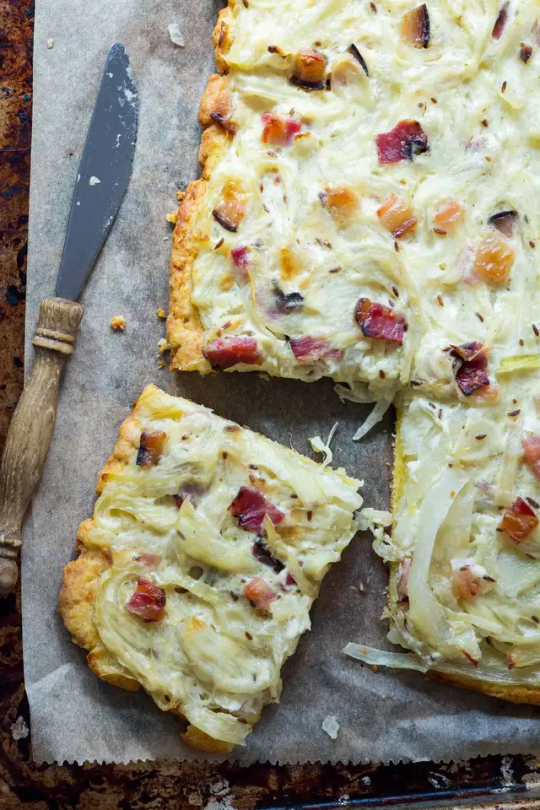
Zwiebelkuchen
162 notes
·
View notes
Text

Old-Fashioned Seed Cake (Vegan)
#vegan#desserts#british cuisine#cake#veganized#seed cake#food irl#caraway seeds#plant milk#lemon#vegan butter#coconut sugar#sea salt
15 notes
·
View notes
Text
My throaaaat hurts
#would have called out of work this morning but time off blackout because busy season#i can still miss work but i cant use vacation to cover it#and its a rent paycheck#and rent is. 100% of my rent paycheck. so. cant miss any pay on rent paychecks. not an option#i thought i had a fever all day because i would alternate between chills and getting super hot#like need to take off my shirt hot#but i couldnt find my thermometer#swung by the grocery store to buy a new one on the way home and it tells me im 94 degrees#sure jan#hopefully the act of having purchased a new one will make the old one turn up#i also tried to pick up caraway seed and lemon zest for caraway seed cake but the grocery store doesnt sell dried lemon peel anymore?#like at all?#and the only caraway seed option is gourmet organic and $10 for a 2oz jar#i would use a third of the jar for one batch#for reference the old brand that i bought i would use the whole jar and it cost $1.25#so uuuuuuh yeah im not paying that#especially since i looked it up and i can order mccormick caraway seed by the pound for less per oz than i was paying before lmfao#they also made it so that fennel seed is only available in the gourmet organic brand -- $8 for a 1.7oz jar#im not paying that either thats highway robbery prices#i might as well just buy the fancy italian sausage#which is why i started buying fennel seed in the first place. to add to ground pork to make it taste like italian sausage#i bet i can find a better option for that from a known company online too#i dont know what they were thinking doing away with the other brand#it was a local company and it offered lots of options at reasonable prices#now theyve got like. the most basic assortment#oregano. basil. cumin. cinnamon. thyme. rosemary. garlic powder#just as i was starting to experiment with more interesting spices too
4 notes
·
View notes
Text
It's past midnight here and I'm up well past crossfaded, making a dessert sauce from the last of my dutched cocoa and some fruit juices (an old clementine and a fresh cara cara and some bottled tart cherry juice) (and honey and maple syrup) (and salt) and it smells like a chocolate orange you'd want to have sex with.
(And some vanilla extract, but only because I'm out of almond extract)
Update: tastes like it, too
2 notes
·
View notes
Photo

European Recipe This seed cake recipe, which has a distinct flavor of caraway seeds, hails from Great Britain.
0 notes
Photo

Recipe for English Caraway Cake This seed cake recipe, which has a distinct flavor of caraway seeds, hails from Great Britain.
0 notes
Photo

English Caraway Cake This seed cake recipe, which has a distinct flavor of caraway seeds, hails from Great Britain.
0 notes
Text
Cooking like a Sailor- Frisian teatime
Today it's going to be a bit Friesian again and this time the delicious treats come mainly from the North Sea islands and Halligen, where they usually originated before they floated ashore and were eaten or drunk there.
Now that we are approaching autumn with great strides, there are such delicacies. This was the time when many of the seafaring men returned home, which meant a rich harvest of specialities from foreign countries and often also the weddings were hold which were arranged the year before.
But let's start with the drink: tea punch, just the thing for the wet and cold season when it's stormy and raining outside.

Ingredients: Black tea, köm and kluntjes (brown sugar candy).
But even more important than the right ingredients are the way it is prepared and consumed. If you are in a hurry, you have no place at the tea punch table!
The tea punch is served as follows: The teapot is placed on the teapot warmer and the pre-heated bottle of Köm is placed on the table. Don't be surprised: the tea punch cups are tiny. This has nothing to do with stinginess, but with cosiness. And this is how it works: Pour tea into the cup, add a dash of köm and sugar to taste. Listen to the Kluntjes crack, stir and drink hot. Have a chat and then top up again.
This drink has existed on the islands since 1735, when a ship with tea chests stranded off Amrum at Theeknobs, although at the beginning there was no knowledge of how to prepare the tea leaves. As a result, the tea was drunk quite thinly, which was also due to the fact that tea was something special that was not always available, just like schnapps. Köm is a spirit similar to aquavit with caraway seeds. The yellow (geele) Köm is particularly common in the North Frisian region. This is a spirit, usually made with grain, which is mixed with caraway and sometimes with a hint of aniseed.
The tea punch was of course also known on ships, but here the köm was swapped for rum and the punch was used to warm up rather than for chatting. Sailors preferred to do this on land.
What do you serve with tea? Hallig Knorken or Friesenwaffeln are best. This wafer-thin delicacy has been around since the 16th century thanks to the Dutch who settled in northern Germany. They were light waffles that were made with rum and then served with plum jam and cream. Again, these delicacies were either brought by the men or had to be bartered or bought on the land, as the islands and Halligen did not have huge areas of land available for agriculture and so there was a lot of trade with the delicacies from the sea.

Ingredients for 4 people (this is the modern recipe) 4 eggs 200g sugar 250g butter 300g flour 3-4 tsp. cornflour 50ml rum 1 packet of vanilla sugar 1 pinch of salt
Bake the waffles in an iron and then serve hot with plum jam and cream.
Now we come to the highlight of every festive table - the Friesentorte. This magnificent cake is truly a precious piece. Because it requires valuable ingredients that were not always available back then and were therefore more likely to be found on festive tables. It is not known when it has been around, but probably since the 19th century, thanks to the sailors who brought many recipes with them from other countries. Like puff pastry, for example.

Today's variations also work with shortcrust pastry, but are not the original recipe
Recipe
Bake two puff pastry bases (you can use ready-made pastry) Brush one of the bases (the top) with egg yolk and sprinkle with caster sugar Leave the second (base) plain After baking, spread the base generously with plum jam Spread not too little whipped cream on the plum jam base Cut the top into 12 even pieces and then arrange the pieces on top.
The wealthier the family the more the cake would consist of several layers. Which made eating even more complicated, because how do you eat this monster without smearing cream all over your face? Well, you take the lid off, eat the inside and nibble the lid separately.
So there you have it and I wish you a delicious tea time of a different kind. Enjoy your tea and your tasty treats like real Frisians.
#naval history#frisian tea time#tea waffels and cake#16th - today#age of sail#age of steam#modern#cooking like a sailor
596 notes
·
View notes
Text
December 2024 Witch Guide
New Moon: December 1st & December 30th
First Quarter: December 8th
Full moon: December 15th
Last Quarter: December 22nd
Sabbats: Yule: December 21st-January 1st
December Cold Moon
Also known as: Aerra Geola, Drift Clearing Moon, Frost Exploding Trees Moon, Heilagmanoth, Hoar Frost Moon, Little Spirit Moon, Long Night's Moon, Moon of Popping Trees, Moon Before Yule, Moon When the Dear Shed their Antlers, Oak Moon, Snow Moon, Winter Maker Moon, Wintermonat & Wolf Moon
Element: Fire
Zodiac: Sagittarius & Capricorn
Nature spirts: Snow Faeries, Storm Faeries & Winter Tree Faeries
Deities: Athena, Fates, Hades, Hathor, Hecate, Ixchel, Minerva, Neith, Norns, Osiris & Persephone
Animals: Bear, deer, horse & mouse
Birds: Robin, rook & snowy owl
Trees: Cedar, evergreen, fir, holly & pine
Herbs: Bay, cinnamon, English ivy, frankincense, mistletoe, myrrh & sage
Flowers: Chamomile & poinsettia
Scents: Cedar, cinnamon, frankincense, ginger, lilac, myrrh, nutmeg, patchouli, pine, rose geranium, rosemary, saffron, violet & evergreen
Stones: Aquamarine, bloodstone, cat's eye, garnet, jacinth, obsidian, peridot, ruby, serpentine, topaz, turquoise
Issues, intentions & powers: Dedication, devotion, love, peace, prosperity & strength
Energy: Alchemy, darkness, endurance, death&rebirth, higher education, reaching out to others, religious, spiritual paths, travel & truths
This full Moon has also been called the Long Night Moon (Mohican), as it rises during the “longest” nights of the year, near the December winter solstice. This name is doubly fitting because December’s full Moon shines above the horizon for a more extended period than most full Moons.
• This December is unique because there will be TWO new Moons. This is called a Black Moon.
A Black Moon is a special kind of New Moon, just as a Blue Moon is a special kind of Full Moon. Neither are astronomical terms; both are catch phrases for an unusual lunar calendar occurrence. For this reason, the definition of a Black Moon can vary and may refer to:
-The second new Moon in a month. This is the definition of Black Moon that’s used most often & it’s the most common. It occurs once every 29 months.
-The third new Moon in a season of four New Moons. Every season (spring, summer, fall, winter) has 3 months & 3 new Moons. However, occasionally (every 33 months), there is a season with 4 new Moons. In this case, the third New Moon is called a Black Moon.
-When there are NO new Moons in a month. This can only happen in February since it’s the only calendar month that is shorter (28 days) than the lunar month. When there is not a new Moon in February, there will be two new Moons for both January & March. It’s a rare occurrence (every 19 years or so) and the next one isn’t until 2033.
Yule
Known as: Alban Arthan & Winter Solstice
Season: Winter
Element: Earth
Symbols: Baskets of clove studded fruit, decorated evergreen trees, evergreen boughs, gifts, gold pillar candles, holly, mistletoe, poinsettias, wreaths & Yule logs
Colors: Gold, green, orange, red, silver, white & yellow
Oils/Incense: Bayberry, cedar, cinnamon, frankincense, myrrh & pine
Animals: Bear, boar, deer, pig, squirrel & tiger
Birds: Eagle, goose, kingfisher, lapwing, robin & wren
Stones: Alexandrite, bloodstone, blue topaz, cat's eye, citrine, clear quartz, diamond, emerald, garnet, green tourmaline, jet, kunzite, pearls & ruby
Angel: Auriel
Food: Caraway cakes, cookies, eggnog, fruits, gingerbread, ginger tea, nuts, pork, spiced cider, roasted boar, roasted chicken, turkey & wassail
Herbs/Plants: Bay, bayberry, blessed thistle, cedar, cinnamon, evergreen, frankincense, holly, ginger, ivy, juniper, mistletoe, moss, myrrh, oak, pine, rosemary, sage, valerian & yellow cedar
Flowers: Chamomile & yarrow
Trees: Birch, cedar, chestnut, fir, holly, juniper, oak, pine & yew
Goddesses: Alcyone, Aphrodite, Ameratasu, Bona Dea, Brighid, Cailleach Bheur, Demeter, Diana, Fortuna, Frau Holle, Frau Perchta, Frigga, Gaia, Great Mother, Kolyada, La Befana, Idunn, Isis, maat & Tiamat
Gods: Apollo, Attis, Baldur, Bragi, Devak, Dionysus, Divine Child, Green man, Janus, Hel, Helios, Holly King, Horned One, Horus, Lord of Misrule, Lugh, Mabon, Marduk, Mithras, Oak King, Odin, Ra, Saturn & Surya
Spellwork: Earth magick, happiness, harmony, love & peace
Issues, Intentions & Powers: Darkness, divination, light, messages/omens, purification, rebirth, renewal & transformation
Activities:
• Set up & decorate a Yule altar
• Clean, organize & cleanse before decorating your home
• Make witch’s balls to hang on your tree (protective & pretty!)
• Decorate & bless & Yule tree
• Stay awake until dawn to observe the cycles of nature
• Give gifts to your family & friends
• Donate your time or helpful items to charity
• Collect snow for winter/ snow magic
• Go caroling
• Hang mistletoe in your doorways
• Make Wassail
• Prepare a Yule Log
• Host a Yule feast
• Craft your own decorative wreath or garlands with oranges, cinnamon & pine
• Decorate your house with Yule colored candles
• Welcome the Sun
• Go on nature walks & leave offerings to nature
• Meditate & reflect on the passing year
“Yule” comes from Old English geol, which shares a history with the equivalent word from Old Norse, jól. Both these words referred to a midwinter festival centered around the winter solstice, which traditionally marked the halfway point of the winter season. After the solstice—the shortest day of the year—the days again begin to grow longer, so it’s thought that Yule was a celebration of the re-appearance of the Sun &the fertile land’s rebirth.
• The celebration of Yule is one of the oldest winter celebrations in the world. Ancient people were hunters & spent most of their time outdoors. The seasons & weather played a significant part in their lives. The customs & traditions associated with it vary widely. Scholars have connected the original celebrations of Yule to the Wild Hunt, the god Odin & the heathen Anglo-Saxon Mōdraniht (“Mothers’ Night”)
• Some believe it marks the rebirth of the Sun (the God) from the Earth (the Goddess) & the cold days of winter will soon begin to wane. The Goddess is seen in her virgin Maiden aspect
In towns and cities throughout Sweden during the Christmas season, large goats are constructed out of straw. It is thought that the tradition originated in ancient times, perhaps as a tribute to the god Thor, who was said to ride in a chariot pulled by goats. In Sweden the goat came to be associated with the Christmas celebration & the Yule goat is now considered by many to be a companion or counterpart to Santa Claus.
This connects to ancient proto-Slavic beliefs where the Koliada (Yule) festival honors the god of the fertile sun & the harvest. This god, Devac (also known as Dazbog or Dažbog), was represented by a white goat. Consequently the Koliada festivals always had a person dressed as a goat, often demanding offerings in the form of presents. A man-sized goat figure is known from 11th-century remembrances of Childermas, where it was led by a man dressed as Saint Nicholas, symbolizing his control over the Devil.
Related festivals:
•Christmas- December 25th:
An annual festival commemorating the birth of Jesus Christ as the son of God. For Christians, believing that God came into the world in the form of man to atone for the sins of humanity rather than knowing Jesus's exact birth date is considered to be the primary purpose of celebrating Christmas.
Hanukkah-December 25-January 2nd:
A Jewish festival commemorating the recovery of Jerusalem & subsequent rededication of the Second Temple at the beginning of the Maccabean Revolt against the Seleucid Empire in the 2nd century BCE.
Hanukkah is observed for eight nights & days, starting on the 25th day of Kislev according to the Hebrew calendar, which may occur at any time from late November to late December in the Gregorian calendar. The festival is observed by lighting the candles of a candelabrum with nine branches, commonly called a menorah or hanukkiah.
Kwanzaa-December 26th-January 1st:
An annual celebration of African-American culture, culminating in a communal feast called Karamu, usually on the sixth day. It was created by activist Maulana Karenga, based on African harvest festival traditions from various parts of West & Southeast Africa. Kwanzaa was first celebrated in 1966.
A Kwanzaa ceremony may include drumming and musical selections, libations, a reading of the African Pledge & the Principles of Blackness, reflection on the Pan-African colors, a discussion of the African principle of the day or a chapter in African history, a candle-lighting ritual, artistic performance & finally, a feast of faith (Karamu Ya Imani).
Saturnalia- December 17-23rd:
An ancient Roman festival and holiday in honour of the god Saturn, The holiday was celebrated with a sacrifice at the Temple of Saturn, in the Roman Forum & a public banquet, followed by private gift-giving, continual partying & a carnival atmosphere that overturned Roman social norms: gambling was permitted & masters provided table service for their slaves as it was seen as a time of liberty for both slaves & freedmen alike.
A common custom was the election of a “King of the Saturnalia”, who gave orders to people, which were followed & presided over the merrymaking. The gifts exchanged were usually gag gifts or small figurines made of wax or pottery known as sigillaria. The poet Catullus called it “the best of days”.
Other celebrations:
Feast of Epona- December 18th:
Eponalia is the feast day of Gaulish Goddess Epona, the Divine Mare & in the time of the Roman Empire
Epona is known to be one of a very few Gaulish deities whose names were spread to the rest of the Roman Empire. This seems to have happened because Roman cavalry units stationed in Gaul followed her & adopted her as their Patroness. This may have started because many of the cavalry troops were conscripted from Gaul as they were superb horsemen. From Gaul the Romans took Epona with them including to Rome where She was given her own feast day on the 18 December. They worshipped her as Epona Augusta or Epona Regina & invoked her on behalf of the Emperor. She even had a shrine in the barracks of the Imperial Bodyguard.
Hunting of the Wren-December 26th:
A traditional custom carried out on the Isle of Man on St. Stephen’s Day. It consists of groups of people going around villages and towns singing and dancing a traditional song and dance around a decorated wren pole.
The earliest and most common folklore story accounting for the origin of hunt the wren tells of a fairy/enchantress/witch whose beauty lures the men of the Isle of Man to harm, for which she is chased and is changed into the form of a wren. It is therefore in punishment for her actions that the wren is hunted on St. Stephen’s Day
Sources:
Farmersalmanac .com
Llewellyn's Complete Book of Correspondences by Sandra Kines
Wikipedia
A Witch's Book of Correspondences by Viktorija Briggs
Encyclopedia britannica
Llewellyn 2024 magical almanac Practical magic for everyday living
#December#december 2024#cold moon#witch guide#December 2024 witch guide#witchblr#wiccablr#paganblr#witch#witch community#witchcore#witchcraft#witches of tumblr#tumblr witches#yule#winter solstice#beginner witch#baby witch#witch tips#grimoire#book of shadows#spellbook#pagan#wicca#traditional witchcraft#holiday#witchy stuff#witchy things#beginner witch tips#baby witch tips
191 notes
·
View notes
Text
Die Moosweiblein
Moss Women
Moss Women are female forest spirits from German legend. They belong to the poor souls.

Moos Women occur in Saxony, Thuringia, on the Saale, in Orlagau, in the Harz mountain, in the Vogtland, in Upper Palatinate, in the Bavarian Forest, in Franconia and Upper Franconia, in the Bohemian Forest, around Warnsdorf in the northern Czech Republic, in the Giant Mountains and in Westphalia.
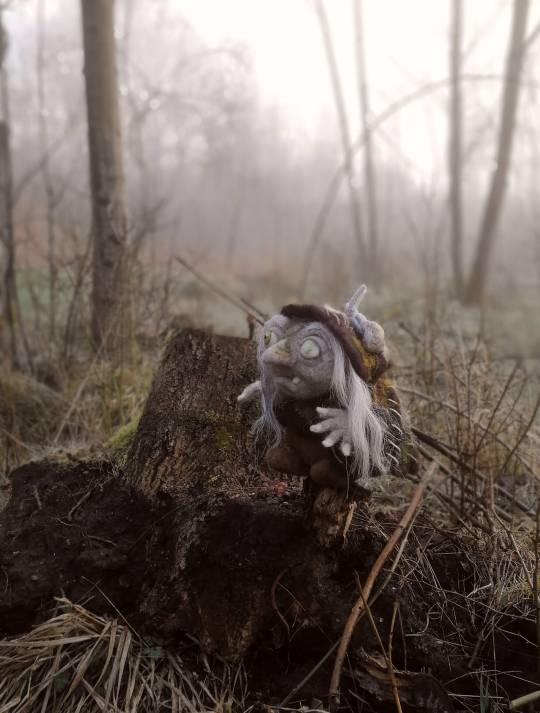
Depending on the region, Moss Women have a different appearance. Most often, they are as short as a three to five year old child. They have an ugly appearance, often entirely covered in moss, and are hunchbacked. They appear to be very old with grey, wrinkled faces abd blackened, blind eyes. They have long black or white unkempt hair. Their voices are high-pitched and squeaky. They are always barefoot. They often carry brushwood in a pannier on their back or in their apron. They use a walking stick to support their unsteady gait.
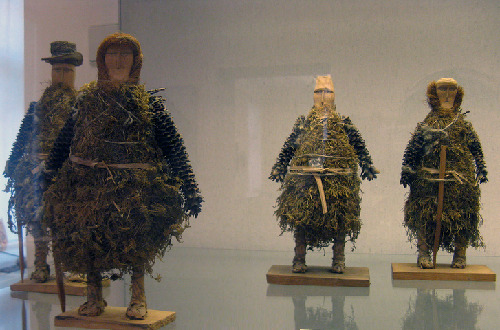
Moss Women are living in the forest, where they are dwelling in underground caves or hollow trees. They are sleeping in beds from moss. They are living in large families and can have children from Wood Kobolds or humans. They like to bake delicious cake, and when they do, mist is coming out of the forest. When politely asked for, they serve the cake also to humans.
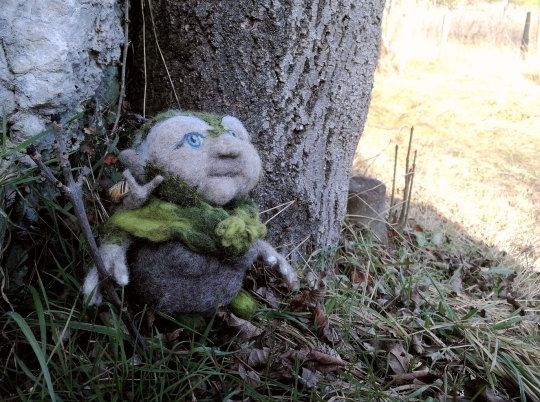
Moss women know herbs and are skilled at both sending and healing illnesses. If people mock them, they send them ailments. This can happen in a variety of ways. They can squeeze people so hard that they become sick and miserable, and they can sit on them so that they become lame. They can also breathe on them, which causes people to get bumps or ulcers on their faces. Moss women also have knowledge of the future.

Moss women reward people by giving them wood shavings or leaves that turn into gold. They also give balls of yarn that never end unless you deliberately look for their end, or webs and knitted items that bring luck and blessings into the house. The moss women also show their gratitude with well-intentioned advice and warnings. They also look after children in the forest, lead people out of the forest at night without getting lost, or help them find deer and roe deer antlers.
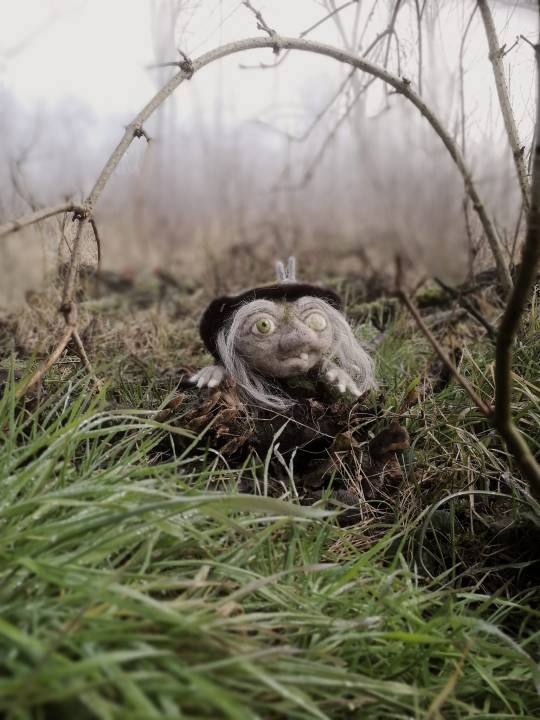
On the other hand, moss women steal bread and dumplings. They cannot tolerate caraway bread, however, which is why they cry out: caraway bread, our death. The same goes for "piped" bread, i.e. bread into which the tip of your finger has been pressed. They cannot touch counted baked goods either. On the other hand, the moss women rightfully own some of the hay cuttings and the water that drops on the rim of the vessel when scooped out, as well as some of the linseed, flax stalks, ears of grain and tree fruit, as well as the flour that sticks to the frame of the bucket and any leftover bread crumbs. Moss women allow people to gather wood in the forest if they first receive a piece of bread or a dumpling as a gift
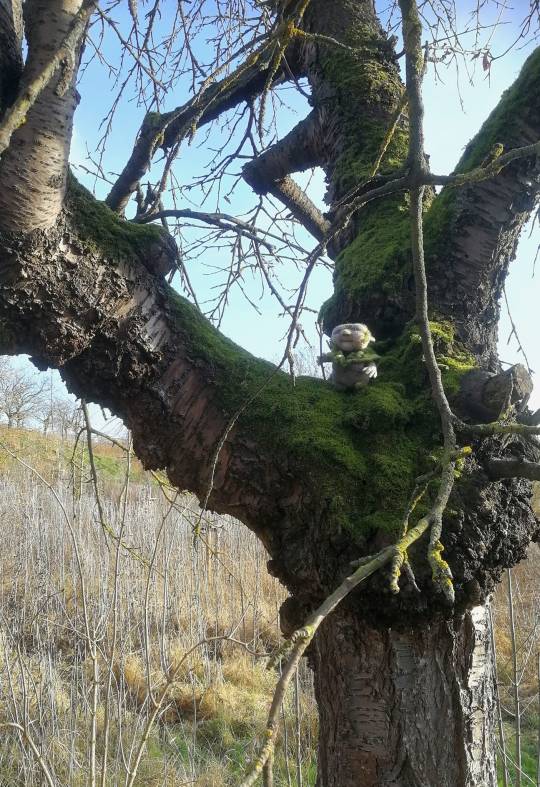
Sometimes moss women help people with deeds and advice. They visit people's houses and do various jobs, for example they spin flax and wool at night, they scrub, feed, milk, mow, help with haymaking and harvesting. If moss women receive food from shepherds, they bless their cows, which then produce more milk. For craftsmen, they protect their tools from thieves. As household spirits, moss women bring luck and blessings, but also require to receive food offerings in return. They detest people's cursing and vices. They love silence, hate quarrels and curses, and are driven away by them, just as they disappear never to be seen again if they are given new clothes. Whenever bast is peeled from a tree, a Moosweiblein must die.
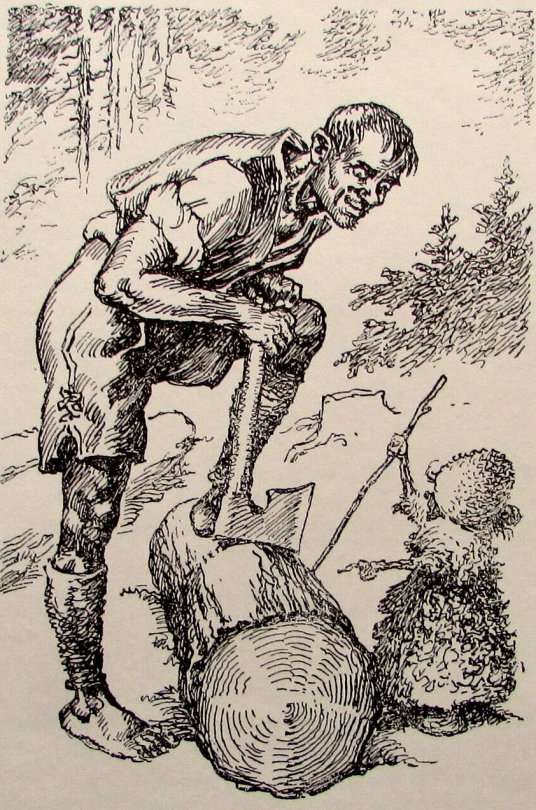
On the river Saale, the Buschgroßmutter (bush grandmother) is known as the queen of the moss women. Strictly speaking, the bush grandmother is the mother of the moss women (here: moss girls), with whom she travels around the country, usually in a small cart. She has messy hair and a fixed gaze. The bush grandmother is also a bogeyman. The bush grandmother also appears in Silesia, where she is called Pusch-Grohla.

392 notes
·
View notes
Text
hello for st patrick's day eve i will share my mom's soda bread recipe. mostly because it's on an absolutely ancient piece of paper that's hard to read & i want it transcribed. all measurements in US
ingredients:
4 cups flour (my mom does 2 cups wheat / 2 cups white. but do all white if you want the traditional look)
1 tsp salt
1 tsp baking powder
2 tbsp caraway seeds (i skip these because i hate them)
3/4 stick butter, softened (i usually do the whole stick for ease. she has crossed out and changed this measurement 5 times. measure with your heart)
1.5 cups raisins
1/2 cup sugar
1.5 cup buttermilk* -- add more if dry (this amount has been changed three times)
1 egg (but "2" is written next to it? genuinely also measured with your heart)
1 tsp baking soda
instructions:
Mix together flour, salt and baking powder (recipe says "sift" but no one in my family has the patience for this). Stir in caraway seeds if you're a monster who likes them. Cut in butter until mixture is crumbly. Add raisins and sugar. In a separate bowl, combine buttermilk, egg and baking soda. Stir liquid into flour mixture until just moistened.** Turn dough onto a floured board and knead a few time until smooth. Shape into a large ball and place into center of a well-greased 9-inch cake pan. Press down slightly. With a sharp, floured knife, make a 4 inch cross, 1/4 inch deep in the center of the dough. Bake 1 hour at 325** degrees (Fahrenheit) or until loaf is nicely browned. Cool on rack.
serving suggestion: eat with lots of butter, preferrably an irish brand like kerry gold
NOTES:
*you can make your own buttermilk by adding 1 tablespoon lemon juice to 1 cup milk (so for this recipe, 1.5 tbsp lemon juice to 1.5 cup milk). let stand five minutes, stir, and proceed with recipe.
**i have just been slowly pouring the whole mixture in. i do not think i have ever actually read the instructions until just now. when i do this, the dough will come out kind of wet and not really hold a shape but the bread will be moist and good.
***the original recipe calls for 350 degrees and i THINK this change was made because our oven ran kind of hot, rather than because it needed less heat? unclear. watch your bread.
47 notes
·
View notes
Text


[ID: First image is of a golden brown boule studded with blueberries and covered with seeds; second image shows the boule cut in half to show a holely bread with blueberries throughout. End ID]
Rustic no-knead blueberry bread
This is a crusty, no-knead, sweet-savory bread that pairs blueberries with spices and herbs inspired by West Asian cooking. Fennel, anise, sesame, and mahlab powder are reminiscent of the دُقَّة كَعْك ("duqqa ka'k"; cake powder) used in pastries, while za'tar and caraway skew more savory.
The long rise yields a well-fermented dough with a robust flavor that stands up well against the sweetness and pungency of the fennel and aniseed. The result is a jammy, complex, aromatic boule.
This bread has an open, irregular crumb, great for slicing, toasting, dipping, or spreading. Try it with labna and honey, olive oil and za'tar, or a spreadable cheese. I've also made sandwiches with thick slices of this bread and fried, glazed tofu drizzled with tarator and topped with Iraqi mango pickles, to excellent effect.
Recipe under the cut!
Patreon | Paypal | Venmo
Makes one medium-sized boule.
Ingredients:
3 cups (360g) bread flour
2 tsp kosher salt
1/4 tsp dry active yeast
2 tsp mahlab powder (optional)
1 tsp fennel seed + 1 tsp aniseed, coarsely ground
About 1 2/3 cup water (room temperature)
1/2 cup firm fresh blueberries
1 Tbsp za’tar (wild thyme), crumbled
Additional fennel seeds, aniseed, caraway, and sesame, to top
Mahlab (محلب) powder is the ground-up pits of Mahleb cherries. It can be purchased at a halal or specialty spice store.
Za'tar (wild thyme) can be found in dried form at a halal grocery store. Note that the spice blend, which includes wild thyme, sumac, sesame seeds, and other spices, will also be labelled "za'tar." If you don't have or can't locate any of the herb itself, use any dried woody herb of your choice (e.g. rosemary, thyme, sage), chopped.
Instructions:
1. Making the dough. Measure flour into a large mixing bowl. Add salt, yeast, seeds, and thyme and stir to combine.
2. Gradually add water until a soft, sticky dough forms. You may need more or less than 1 2/3 cup.
3. Flatten dough in the bowl and top with some of the blueberries. Fold the dough to enclose the blueberries, add more blueberries on top, and fold again. Repeat until all blueberries are incorporated.
4. First rise. Shape dough into a ball and place in the bowl seam-side down. Pat the top of the dough with some olive oil and cover the bowl with a kitchen towel. Allow to rest at room temperature for 16-20 hours.
5. Shaping. Gently remove the dough from the bowl and allow it to deflate. Shape the boule by folding an edge in over the center, rotating the dough slightly, and repeating until you have gone all the way around.
6. Flip the ball over so the seam side is down. Place your hands on either side of the dough and then move them down towards the base of the boule, tucking some of the dough under and towards the seam, to tighten the top of the ball. Rotate the ball slightly and do this again, repeating until you've gone all the way around a couple times.
This is the basic method for shaping a boule, lightly adapted to avoid breaking any blueberries. If any of the blueberries start to pop out of the surface of the dough, just press them back in.
7. Second rise. Place your boule on a piece of parchment paper and cover with a kitchen towel. Allow to rise for 1-2 hours, until noticeably puffy.
8. Baking. Place a Dutch oven in your oven and preheat to 450 °F (230 °C). Remove the Dutch oven and place the boule, along with the parchment paper, inside. Put the lid on the Dutch oven and return it to the oven. Bake for 30 minutes.
9. Remove the Dutch oven's lid and bake bread for another 20 minutes, or until the crust is deeply golden brown.
To bake the bread without a Dutch oven, preheat a baking tray in the center of the oven, while preheating a skillet (rated to at least 450 °F) in the bottom; once preheated, transfer the bread and parchment paper to the tray, and pour a few cups of water in the skillet; bake for 30 minutes. Remove the skillet and bake another 20 minutes until golden brown.
Allow the bread to cool completely before cutting into it to avoid creating a mushy texture.

221 notes
·
View notes
Text

First batch of caraway cakes are out of the oven! They’re not pretty but neither am I ;)
29 notes
·
View notes